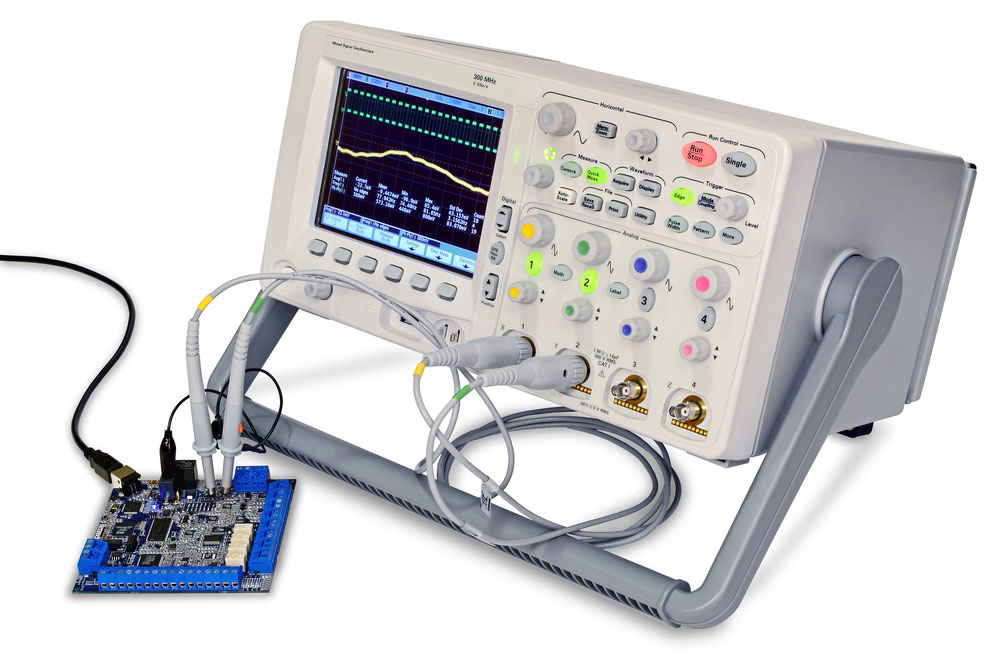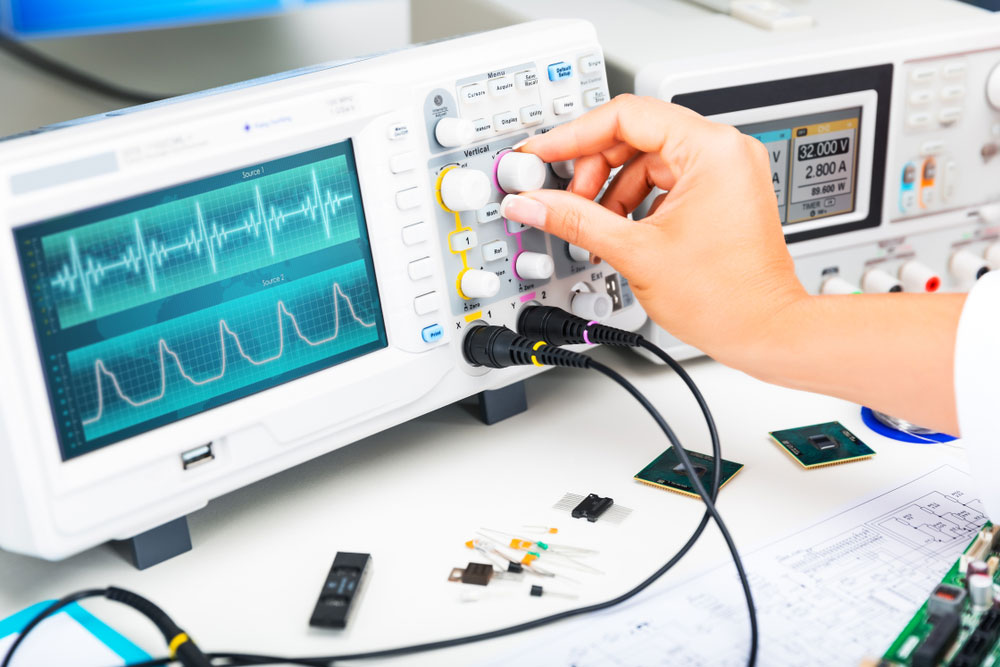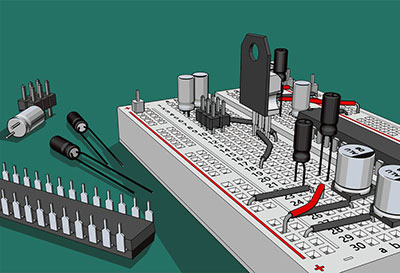Most consumer products nowadays, including vehicles, contain electrical circuits or components. So you need a testing and diagnostic instrument for the product design process to ensure the device operates as required. One of the most typical instruments used for these applications is the oscilloscope. But what is an oscilloscope? And what are its applications? We will list the oscilloscope uses below to answer these questions. Read on to learn more!
Contents
- What is an Oscilloscope?
- Types of Oscilloscopes
- Analog Oscilloscope
- Digital Oscilloscope
- Handheld Oscilloscope
- What Does an Oscilloscope Measure?
- Oscilloscope Uses
- Vehicle Repair
- Medicine
- Telecommunication
- Education
- Time Domain Reflectometry
- Power Analysis
- Testing Data Storage Devices
- Jitter Analysis
- Serial Data Analysis
- Tracing Signals
- Performing Sophisticated Calculations on Several Waveforms
- Analyzing Analog Output Sensors
- Wrap Up
What is an Oscilloscope?
Oscilloscopes are electronic diagnostic test instruments that display a time-varying voltage signal. They contain cathode ray tubes to generate electron beams that get directed to a fluorescent screen to create the electrical signal waveform. This signal is in a voltage-over-time graph, with time on the X-axis and voltage on the Y-axis. You can examine the resulting waveform for properties like time intervals, distortion, amplitude, frequency, and rise time. For complex signal integrity solutions that ensure your PCB performs reliably at high frequencies, our engineering team is ready to review your specific requirements.

A digital oscilloscope
Usually, the device displays two proportional graphs of one or more electrical signals as a function of time. And they have the advantage of adjusting in-order-for repeated signals, which you can see as a proceeding figure on the oscilloscope display. Digital and analog storage scopes can capture one scene and display signals as repetitive waveforms. So you can observe scenes that are too short to view directly.
Special Offer: Get $100 off your order!
Email [email protected] to get started!
Types of Oscilloscopes
There are three primary types of oscilloscopes.
Analog Oscilloscope
Analog scopes have the same operating principles as tube televisions. An electron beam formed on the cathode ray tube creates an image of the signal waveform when it hits the phosphor screen. The input signal applied to the horizontal and vertical position control deflector coils forms the electron beam.

An analog oscilloscope
Digital Oscilloscope
Most technicians prefer the digital oscilloscope over the analog one because it features advanced microprocessors. So it can transmit incoming signals faster and with more accuracy.
This digital scope has several subtypes, which include the following.
- Digital Storage Oscilloscope (DSO): can display complex signal waveforms
- Digital Phosphor Oscilloscope (DPO)
- Fluke or portable Digital Storage Scope
- USB (PC-based) Digital Storage Oscilloscope
- Two-channel Digital Storage Oscilloscope
- Four-channel Digital Storage Oscilloscope
- Mixed Domain Oscilloscopes (MDO)
- Mixed Signal Oscilloscope (MSO)
- Digital Sampling Oscilloscope

A digital storage oscilloscope
Handheld Oscilloscope
This oscilloscope has one primary advantage: it is tiny and portable. It is typical in field studies applications, and you can power it using rechargeable or external non-rechargeable batteries.
What Does an Oscilloscope Measure?
While oscilloscopes primarily measure voltage, you can use them to detect other electronic signals, such as the following.
- Current: You can use a current probe to detect electric current or measure the voltage drop across a shunt resistor.
- Sound: To measure sound using an oscilloscope, use a transducer to convert the audio signal to voltage, then connect the channel to the device. This conversion will give you the sound voltage vs. time.

A modern digital oscilloscope measuring a PCB
- Capacitance: Like sound, an oscilloscope cannot measure capacitance directly. But you can measure a time constant to determine a component or electrical circuit's capacitance using an Arbitrary Function Generator.
- DC Voltage: Most modern oscilloscopes have a DC voltage measurement function. But if yours does not have it, you can measure manually by counting the vertical reticles and multiplying it by the volts in each division.
- Inductance: The best device to measure inductance is an LCR meter. But if you don't have it, you can use a function generator and an oscilloscope to measure inductance. The measurement will have a 3-5% uncertainty value.
- Frequency: Modern oscilloscopes can also measure frequency signals automatically. But you can do this measurement manually by calculating the signal's period using the horizontal reticules/cursors. After that, you divide one by this period to get the frequency.
Oscilloscope Uses
Oscilloscopes are typical in science applications, especially physics, to examine the effects of multiple surrounding changes. But they are also ideal for the following applications.
Vehicle Repair
Mechanics can use automotive oscilloscopes to examine fuel injectors or cars with starting problems. The electronic device ensures effective repairs and provides a quick diagnosis.

An automotive oscilloscope
Medicine
Ever heard of a flatline? Healthcare professionals use oscilloscopes to measure patient heartbeats, which appear as waveforms. A flatline implies the heart is not beating (dead). These professionals also use this electronic test device to monitor brain waves during diagnostic tests.

A medical monitor with a flatline to signal a patient’s clinical death
Telecommunication
Like mechanics and engineers, technicians need oscilloscopes to fix computers, phones, radios, televisions, sound systems, etc.
Education
All technicians and engineers involved in testing and diagnosis must undergo training, a task that requires oscilloscopes. The training involves:
- Appreciating intricate loops
- Observing electronic circuit points
- Viewing changing waveforms in analog circuits
- Transmitting bits and bytes in digital channels from one digital device to another

An engineer on a workbench with several instruments, including an oscilloscope
Additionally, you can excavate the electronic test instrument by dismantling the rear panel to learn more about analog and modern complex circuits.
Time Domain Reflectometry
TDR is a method that measures the opposition flow of values and variations in a circuit. This flow includes faults in transmission cables, cable connectors, and microstrips.
Power Analysis
Oscilloscopes can test and weigh the operational features of power harmonics, devices that convert power, and circuits (circuit boards). But this application requires special software and distinct amplifier oscilloscope probes to simplify data analysis.

A digital oscilloscope
Testing Data Storage Devices
Oscilloscopes can test disk drives by checking the disc performance, optical recording characteristics, and media noise.
Jitter Analysis
High circuit bandwidth features clocks and speed signals. Oscilloscopes can help you eliminate signal jitter and determine characteristics like clock data & timing, data sequence, etc.
Serial Data Analysis
Serial data transmission is more cost-efficient than its parallel counterpart, making it typical in modern applications. Scopes can resolve and characterize data formats like Bluetooth, fiber channel, CAN bus, SCSI, rapid I/O, InfiniBand, USB, and Serial ATA.
Tracing Signals
A Digital Storage Oscilloscope can help technicians determine the signals to monitor for a failing or faulty component. The digital instrument can track unexpected signals and diagnose tiny variations during circuit component operation. Signal tracing is one of the most underrated applications of these electronic instruments.

A digital storage oscilloscope
Performing Sophisticated Calculations on Several Waveforms
Oscilloscopes can add one sound wave to another. Building a jammer circuit for specific sound frequencies requires you to provide the results of this circuit as an input signal to any scope channel. And you need to connect the wave sound to another channel. When you add the two sound waves, a flat line will indicate a working range.
Analyzing Analog Output Sensors
There are genuine and fake analog sensors in the market. An oscilloscope can help you diagnose the sensor behavior before connecting it to your circuit.

A modern digital storage oscilloscope
Wrap Up
In conclusion, oscilloscopes are critical testing and diagnostics instruments for several applications in multiple industries. It primarily displays a voltage over time graph, but you can expand its uses to cover several measurements and unlock even more applications. That's it for this article. Contact us if you have any questions or need help sourcing an oscilloscope for your project.
Special Offer: Get $100 off your order!
Email [email protected] to get started!






